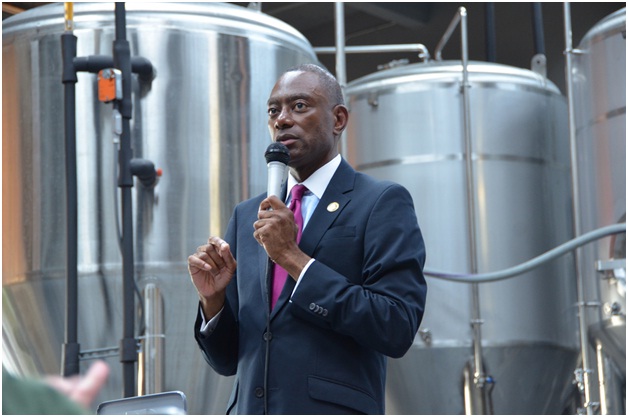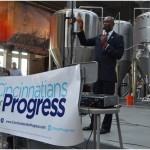Hosting their monthly Streetcar Social, Cincinnatians for Progress braved the summer heat wave at Rhinegeist Brewery as crowds gathered to listen to the featured speaker of July.
Cincinnati Mayor Mark Mallory (D) took to the stage, presenting an update on phase one of the Cincinnati Streetcar project, to a room filled with approximately 200 supporters. Several City Council members were also present, including Wendell Young (D), Laure Quinlivan (D), Chris Seelbach (D), and representatives for Vice Mayor Roxanne Qualls (C) and City Council Candidate Mike Moroski (I).
The Mayor spent the beginning of the event mingling with the crowd, followed by delivering a 20-minute presentation that recapped the official signing of the streetcar construction contract with Messer, and the continued progress with utility relocation along the phase one route.
An updated CAF streetcar model was shown with interior finishes, and Mayor Mallory explained that Cincinnati’s five streetcars will have cutting-edge technology that will be the first of their kind to operate in North America.
Mayor Mallory also showed a rendering of the streetcar maintenance facility, which will be erected in the lot adjacent to Rhinegeist, and explained that the current cinder-block structure will be demolished so that the new facility can be built along Henry Street.
“We’ve decided to name the maintenance facility the Center of Advanced Streetcar Technology, or COAST for short,” Mallory quipped to a boisterous audience, as he commented about the anti-streetcar group with the same acronym.
The mayor continuously expressed his gratitude for supporters, both new and those who have been on for the long haul.
“Investing in the Cincinnati Streetcar will help stabilize the city’s tax base and repopulate the Queen City; the greatest challenge facing us today.”
All photographs were taken by Paige Malott and Travis Estell for UrbanCincy.








